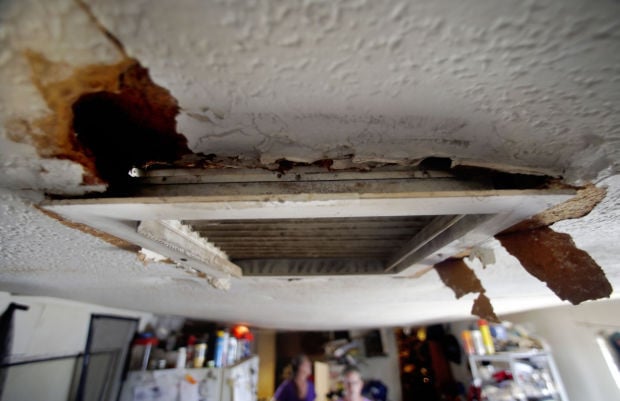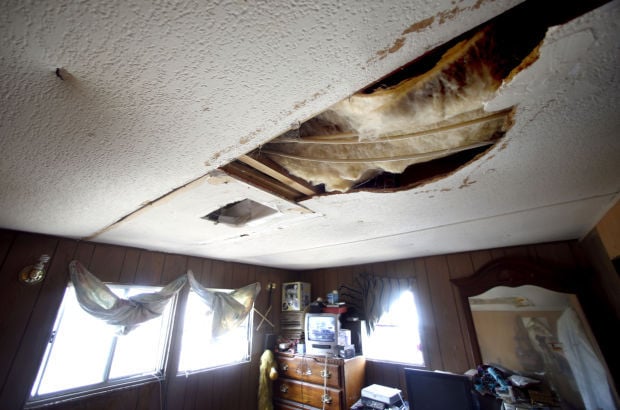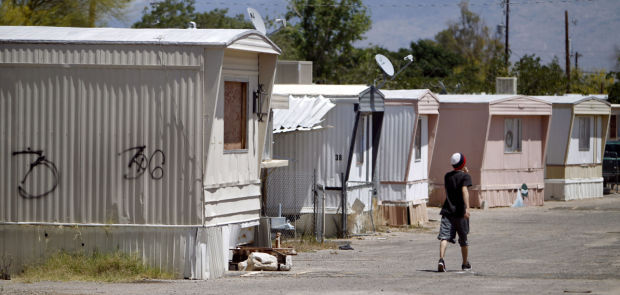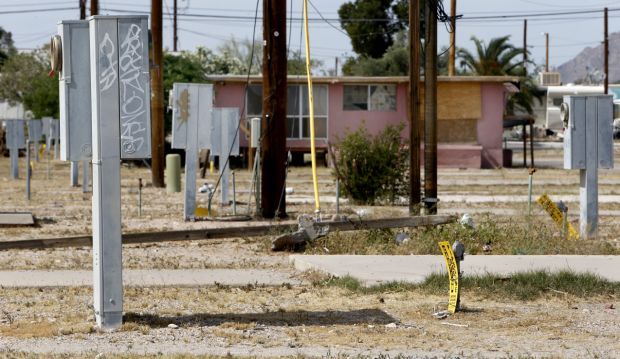While pregnant with her son, 30-year-old Joani Bonjour lived in a northwest Tucson trailer rife with black mold.
And that was a step up: In the trailer before, she had to splash through puddles during monsoon season to get to her bedroom. The roof was covered by a tarp held down by rocks.
Still, Bonjour was grateful for her trailers at Twin Palms mobile home park. The park owner worked with her for months after her boyfriend lost his job and they struggled to pay rent. He eventually evicted them, but she doesn’t hold a grudge.
“People like us, they really helped out,” she says. “We didn’t have anywhere else to go.”
Metro Tucson’s 44,000 mobile homes in roughly 430 parks range from safe and well-maintained to filthy and hazardous. In the worst ones, plumbing breaks and electrical hazards are common. Many of the dilapidated trailers have leaks and structural weaknesses. Residents live by the whims of landlords, and property managers who know their tenants, especially the elderly and disabled ones, are out of options.
The problems are well known to local and state housing officials. Yet they rarely take steps to clean up the parks — or shut down the most egregious offenders of fair housing and building code standards — because Tucson has no better alternative for its poorest residents.
Mobile homes, which comprise 10 percent of Pima County’s housing stock, offer some of the area’s most affordable housing. Shutting down a badly run park, or condemning a crumbling 60-year-old trailer, can push the occupants into homelessness, advocates say.
“It’s a huge dilemma,” says Evelia Martinez, project manager with the Southwest Fair Housing Council in Tucson. “Unless you have something better to offer, why would you displace a family that’s getting by, living a family of five in a one-bedroom mobile home?”
‘NIGHTMARE’ CONDITIONS
Some mobile home parks across the state are practically unlivable, says Joe Scelza, vice president of the Arizona Association of Manufactured Home and RV Owners. The group organizes and lobbies for mobile home park residents who own their trailers and rent the land underneath.
“They’re lean-tos. They’re worse than tents because they have fire hazards in them,” Scelza says. “It’s a nightmare.”
Sewer system breaks can cause raw sewage to pool underneath trailers, and outdated electrical systems can spark fast-moving flames. Leaking trailers often have black mold on the walls or collapsing roofs. Some older models have particle-board floors that basically disintegrate when wet.
Many mobile homes have urgent problems that need an immediate fix, and city and county services aren’t always equipped to respond, says Scott Coverdale, executive director of the nonprofit Community Home Repair Projects of Arizona, one of the few options for low-income homeowners in need of emergency repairs. Half of the group’s work is in mobile homes.
The nonprofit used to get up to $250,000 a year from the Arizona Department of Housing, but the funding was eliminated a few years ago. Cuts to federal funding for the program, as well as to funding for city and county repair services, has made it harder to address all the needs in the parks, he says.
Sometimes a park owner will refuse to fix problems with the park’s sewer system, leading to sewage back-ups inside trailers. Even though park owners are supposed to pay for such repairs, Coverdale sometimes unclogs the system on behalf of the tenants.
“We want to hold the park owners responsible,” he says, “but we’re also trying to help our clients get out of a difficult situation.”
WHY IT’S A PROBLEM HERE
Poorly maintained, aging housing is not unique to the mobile home parks in Tucson, where poverty is high, wages are low and affordable shelter is in short supply.
Across Arizona, nearly one in four working families spend more than 50 percent of their income on housing, says a February report from the nonprofit Center for Housing Policy in Washington, D.C. That puts the state among the worst for housing affordability.
Low-income mobile home park tenants are especially vulnerable to exploitation. They might have no means of transportation, no savings for a security deposit elsewhere and no resources to take legal action if a landlord violates lease conditions. They may be undocumented immigrants, who often seek out mobile home parks because many don’t do background checks on tenants.
“A lot of times they are abused and taken advantage of because they live in fear of being on the street and being deported,” says Debra Blake, deputy director of the state’s Office of Manufactured Housing. “They’re grateful to have a roof over their head and they’re afraid. Well, they shouldn’t be here illegally, but how do you fix that?”
Tucson park owner Kirk Saunders says many mobile home park tenants make a rational decision to live in a substandard trailer — and they aren’t necessarily victims.
“These aren’t stupid people,” Saunders says. “They go in and they see the toilet’s broken and the roof leaks.” But the trade-off may be worth it to someone who is desperate for shelter or whose criminal background precludes any other housing option, he says.
Mobile home parks are not regulated by any state entity. They don’t have to be licensed and have no required regular inspections. (Trailers get an inspection before they can qualify as Section 8 housing.) That means the degraded conditions of the oldest trailers and surrounding infrastructure go unchecked unless someone reports a code violation.
And that’s not likely to happen. Residents often fear a landlord’s retaliation if they complain, says Teresa Williams, the city’s code enforcement division administrator. Residents of a well-kept park might complaints to her office repeatedly about an overgrown shrub, while at a rundown park with rampant violations residents don’t complain for months — or years — at a time.
Lack of affordable housing plays a role, says Anna Sanchez, administrator of Tucson’s Housing and Community Development department.
Residents “understand that if they complain, it may mean the park gets shut down and they don’t have any other housing,” she says.
In 2012, Pima County had 17 affordable rental units available for every 100 extremely low-income renter households, defined as earning less than $18,100 for a household of four, says an analysis of Census and federal housing data by the Urban Institute, a Washington, D.C.-based research group. That’s compared with a national rate of 29 affordable units per 100 poor households.
“It’s a big problem, and we know that,” Sanchez says. “It’s just a difficult situation all around.”
REACTIVE SYSTEM
The city has tried to tackle code violations in the past.
The Slum Abatement and Blight Enforcement Response project, piloted in 2001, cleaned up dozens of properties in mobile home parks and other substandard housing. The effort led to the Neighborhood Preservation Ordinance in 2003, which strengthened minimum-housing standards for landlords and their properties.
When parks are empty, the city’s Vacant and Neglected Structures program can step in. Last year, it tore down all 18 trailers in Desert Blossom park in northwest Tucson, where every trailer was vacant and dilapidated.
But for the most part, the concerted effort of a decade ago has evolved into a reactive code-enforcement system that is complaint-driven, officials say.
Tucson code enforcement has 17 inspectors today, compared with 25 seven years ago. After staffing cuts in 2007, the City Attorney’s Office eliminated the “neighborhood prosecution team” that partnered with code enforcement to penalize slumlords, says City Attorney Mike Rankin. He helped establish the slum-abatement program in 2001.
“We’re still trying to do what we can with the existing people in the prosecutor’s office,” Rankin says.
COUNTY CODE ENFORCEMENT
In the city, code enforcement is consolidated in one department, but that’s not the case in surrounding Pima County. Complaints about electrical hazards go to the local fire district. Sewage or environmental health issues go to the Department of Environmental Quality.
No county ordinance targets slums and slumlords, so code enforcement has no authority to tackle substandard housing inside homes, says Yves Khawam, the county’s chief building official.
Tenants with problems in their mobile home’s interior can file a complaint with the state’s Office of Administrative Hearings for $50, an alternative to civil court, and get a hearing with an administrative law judge. The county has considered adopting a neighborhood preservation ordinance like the city’s, but “we do not have the resources to go after these types of issues,” Khawam says.
Residents in the county parks say code enforcement is weak there. Los Ranchitos mobile home park is in a triangle of county land on the southeast side of the city that is brimming with mobile home parks.
“The inspectors are lax,” says resident and trailer owner Kathy Kellersman. “It don’t take much to say, ‘Oh my God, someone’s living in that?’”
When she and her husband moved into the park four years ago with their three sons, they say park owners offered them trailers with mold, roof leaks, holes in the floor and questionable wiring.
“A good, decent tent would have been a hell of a lot cleaner and safer,” says John Kellersman, who works at Auto Zone. They bought the best one they saw and joined the 76 percent of Pima County mobile home residents who own their trailer.
Last year, the entire park went without water for two weeks. Then-owner Scott Greene didn’t respond to calls seeking comment.
A lack of political will for change — and the dilemma over where to put residents whose homes are condemned — has stymied efforts to clean up the parks, says Gary Bachman of the Pima County Community Development and Neighborhood Conservation Department.
“If we had a multimillion dollar grant, we could probably get somewhere,” he says.
In the absence of resources, parks are home to families like the single mother and her children assisted by Jackie Franco, family resource liaison for Flowing Wells Unified School District. The family lived in a trailer that had no doors and had holes in the floor.
To the overwhelmed mother, Franco says, what mattered most was keeping a roof over her children’s heads. “They all had a place to sleep,” she says. “They just covered up the holes.”
TOLERATING SLUMS
Ron Sande, 71, owns, and has done extensive work on, a 1960 trailer which he says “should have been in a landfill 15 years before I bought it.”
He has lived in Shady Lane mobile home park in Flowing Wells since 2000. New owners took over in 2011 — they added water meters to half the trailers and raised the rent without notice, he says. Residents have gone without heat or air conditioning. In one trailer, the toilet is sinking through the bathroom floor and has been for years, the occupants say.
Calls to Shady Lane park’s owner, Blanca Ashley, resulted in two hang-ups and two unreturned messages.
Sande, who worked at Home Depot until his recent retirement, says he tried to organize the tenants to put pressure on the new owners, but many are on disability, with fixed incomes, and fear eviction.
“They won’t stand up for themselves,” he says. “They won’t push back.”
But Sande isn’t worried: He just got approved for Section 8 housing, which has more than 8,300 people on its waiting list. He plans to move soon.
Park owners deal with a complex population, says Saunders, who owns a park in Sahuarita and 10 more in Phoenix, Texas and California.
While the vast majority of his tenants work hard to pay their rent and keep up their homes, others who own their trailers refuse to maintain them. Some bring drug activity into the parks.
He recalled one Phoenix tenant with untreated mental illness who was threatening to hurt neighbors and needed care far beyond what a landlord could provide.
“We’re in the heart of the socioeconomic challenges of America,” he says. “It’s not just about a bad landlord doing bad things to great people.”
‘NOT ALL SLUMLORDS’
Some mobile home parks in Tucson offer quilting classes, 24-hour security, weekend barbecues and pristine pools.
High-end parks, such as Pantano Vista in East Tucson, sell $95,000 manufactured homes on 6,000-square-foot lots that are almost indistinguishable from site-built houses. Some low-income parks are run by dedicated managers who stretch their budgets to maintain the premises.
“We’re not all slumlords,” Saunders says.
But some unscrupulous park owners prey on families who see homeownership as the path to a better life, says Martinez of the Southwest Fair Housing Council. They sell trailers with a junk value of $500 for 10 times as much. They find a pretext to evict people whose rent is supposed to go toward buying their trailer, and then they find a new buyer and do the same thing again.
Most park owners fall between those extremes. Eric Anderson, owner of Twin Palms Mobile Home Court, where Bonjour lived, acknowledges it’s tough to maintain aging trailers in his 50-year-old park. But he says he tries to respond to residents’ requests quickly — especially if there is a leak or black mold.
“I’m not ashamed of it at all,” he says. “There’s no end to the amount of maintenance. ... You have to keep a focus on continually keeping things better.”
He says he has owned Twin Palms and another nearby park for two decades. To keep rents low, he rehabs older trailers rather than replace them with newer ones.
But the economy is making it harder for park owners to keep up with needed maintenance, he says.
“I can see where some (owners) get stretched so thin they don’t have the resources to do the upgrades that are necessary,” he says. “But once you start losing in that direction, how do you come back from it?”
It’s unfair to single out mobile homes from all of the substandard housing in Tucson, says Saunders, who is also a board member of Manufactured Housing Communities of Arizona. The group advocates for owners of mobile home parks.
“Mobile homes represent a fraction of the dilapidated houses in the county,” he says. “Having said that, I think it’s abominable that those conditions exist and somebody has no choice but to live in radically bad housing, or live on the street.”
But Saunders is not buying the argument that park owners are solely to blame. Government shares the responsibility, he says.
“You’ve got this whole paternalism of government and people who don’t think people should live in substandard housing,” he says. But officials do little to offer real alternatives and take slumlords to task.
“They don’t do the code enforcement that they should because it takes time and resources and they’ve got to file lawsuits, and they don’t have the stomach for it,” he says. “If the city really wanted to crack down on substandard housing, they would.”
ZONING EVOLUTION
Most mobile home parks in the city limits were originally built on unincorporated Pima County land that has since been annexed. And lots of older parks have been grandfathered in as “non-confirming use” sites, allowing them to stay put as modern zoning evolved around them. That makes it tough to spot violations without researching which rules the park must follow.
More than one-third of Tucson’s trailers were built before a 1976 federal law established building and safety standards for mobile home construction, a 2001 survey of local mobile home residents found.
“Some people try to stretch them out as far as they can,” says Williams, of Tucson’s code enforcement division. “There is no state or city code that says a trailer can only be lived in for so long.”
In the Northwest Fire District, lots of parks were built without input from fire departments, but modern parks have to ensure fire-truck access throughout the park and a water supply, says Capt. Adam Goldberg, spokesman for Northwest Fire. As many as 20 older parks in his district don’t have fire hydrants.
“How do you have a 250-trailer mobile home park and have no fire hydrants?” he asks.
The fire district requests federal Community Development Block Grant money each year to add hydrants at trailer parks, and for the past seven years has been adding about two a year, at a cost of $10,000 each.
“We’re basically trying to play catch up,” he says.
Mobile home fires are more likely to be fatal because flames races through the structures, Goldberg says. Some pre-1976 models have aluminum, instead of copper, wiring that becomes hot with use and they lack smoke detectors.
The Tucson Fire Department responded to 46 mobile home fires between April 1, 2013, and April 1, 2014. Northwest Fire was dispatched to 50 mobile-home fires in 2013, including smoking or flaming electrical outlets.
‘HOSTILE’ LOCAL GOVERNMENTS
Park owners face their own challenges.
Zoning regulations require minimum space between each trailer — 3 to 40 feet, depending on the zoning — making it difficult to replace old, deteriorating units with newer and wider ones. Owners keep decaying models in use to avoid money-draining vacancies, says Mike Parham, legal counsel for Manufactured Housing Communities of Arizona, a lobbying group representing the interests of park owners.
A 2013 court decision involving a Benson mobile home park clarified that grandfathered mobile home parks are exempt from spacing requirements between trailers, but zoning officials haven’t enforced that consistently, Parham says.
“There’s this idea in the mind of the public that these are sleazy trailer parks,” he says. “And because of the perception of the industry and hostility of local zoning toward it, it’s very tough to run a quality project.”
Low-income tenants are caught in the middle.
In a tiny northwest-side park without a name, a woman and her 28-year-old daughter live in a trailer whose ceiling buckles in every room. In the bedroom, insulation hangs out of a gaping hole — as it has since the mother reported it to their landlord two years ago. Black mold grows under the sink. The floorboards are broken and coming up in the kitchen, ever since the rainy week when water poured through the broken light fixture above.
“For six nights in a row I was up bailing water out of the kitchen,” the mother says. “We keep anticipating, when is the rest of the roof going to collapse?”
The pair, both on disability, have lived here for eight years. After two years on the waiting list, they hope they are on track to get Section 8 housing soon.
Until then, they will not make waves. They were evicted from a rental unit in Texas after complaining to the landlord about exposed wiring and a collapsing floor.
This time, they will not report code violations in their home. They beg a reporter not to print their names or even the location of their park.
This time, they’ll wait quietly.
“I’m worried about being retaliated against,” the mother says. “We’re afraid we’ll be put in the street again.”









